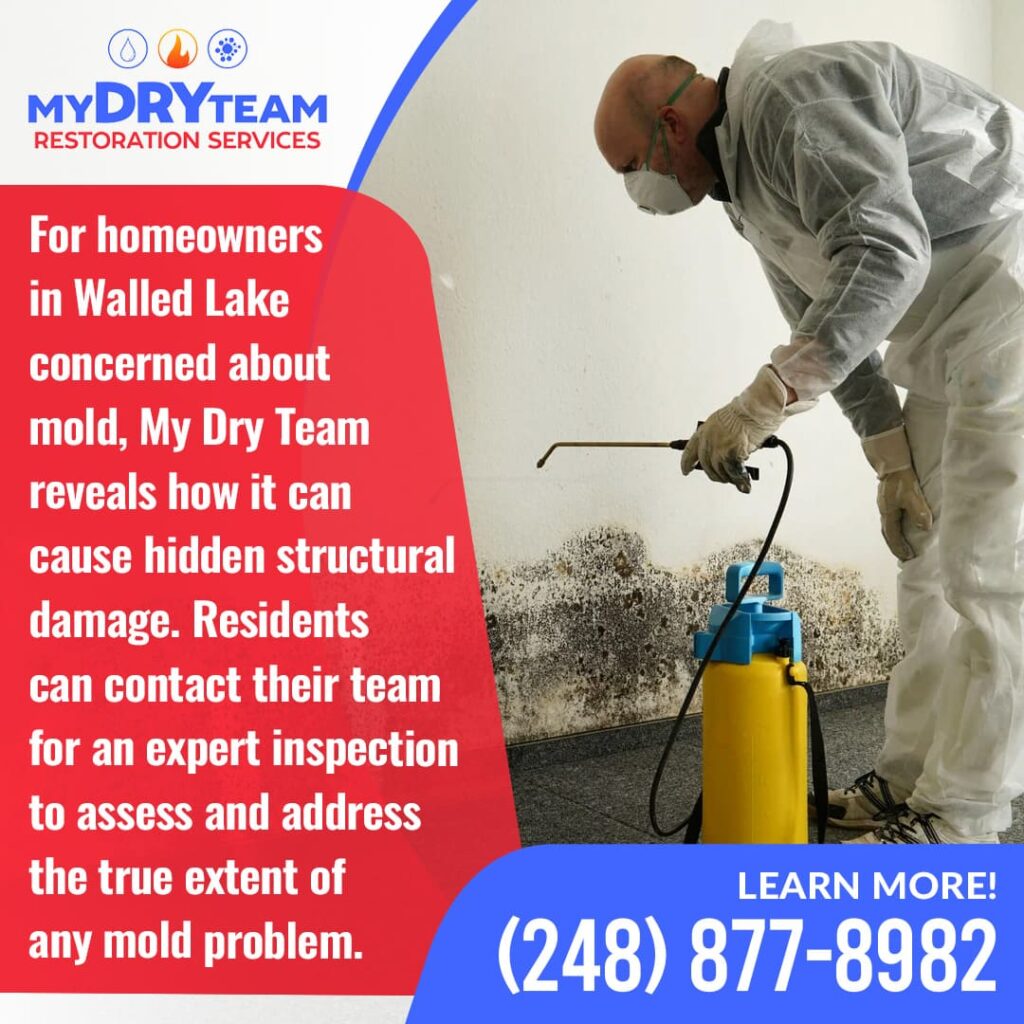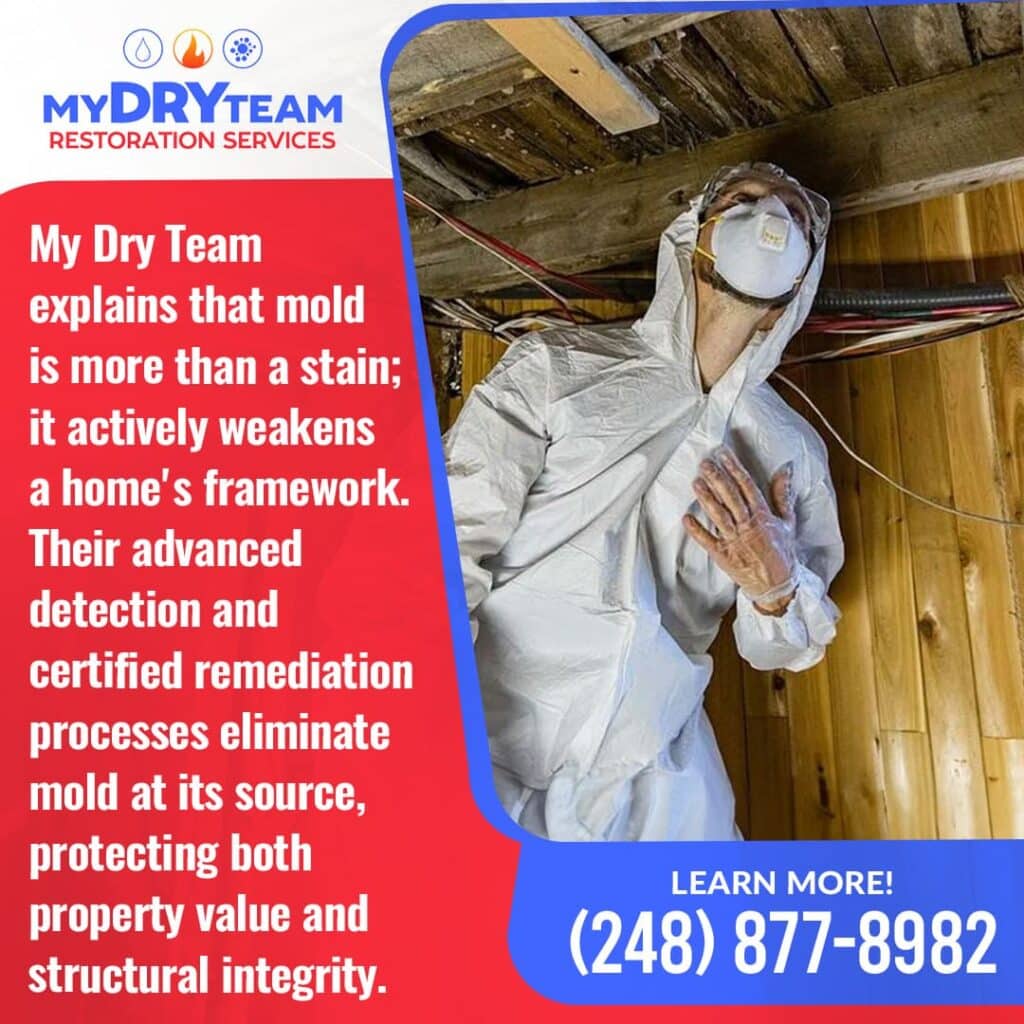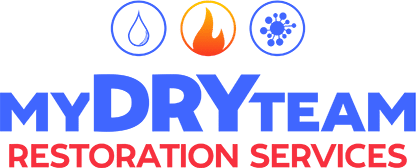Most Walled Lake homeowners know the structural danger posed by termites or water rot. But a lesser-known, silent threat is just as destructive: mold.
Mold isn’t just a surface stain. It’s a living organism that actively consumes and decomposes the materials your house is built from.
Many residents view mold as a simple cleaning problem. They see dark spots on bathroom walls or basement corners and think surface scrubbing will solve the issue. This misconception can cost thousands of dollars in structural repairs.
Mold operates as a biological demolition crew. It systematically breaks down organic building materials from the inside out. The visible surface growth represents only a fraction of the actual damage occurring within your home’s framework.
My Dry Team Restoration Services has documented numerous cases where small moisture issues escalated into major structural problems. Understanding how mold attacks your home’s structure helps homeowners recognize when professional mold remediation becomes necessary.
The warning signs of structural damage differ significantly from surface stains. Proper identification can prevent minor moisture issues from becoming major reconstruction projects.

The Science of Decay: How Mold Literally Eats Your House
Mold’s Diet: The Organic Materials in Your Home
Mold is a type of fungus that feeds on cellulose-based and organic materials. Modern homes provide abundant food sources for mold growth. The paper backing on drywall contains cellulose fibers that mold consumes readily.
Wood studs and floor joists serve as primary structural supports and mold nutrition sources. Plywood subflooring provides another cellulose-rich target. Even the cellulose fibers in insulation become food for hungry mold colonies.
Mold doesn’t discriminate between expensive and cheap materials. Premium hardwood flooring becomes just as vulnerable as basic construction lumber. The organism seeks moisture and organic content regardless of material cost or quality.
Building materials manufacturers now produce mold-resistant products. However, most Walled Lake homes built before 2000 contain traditional materials that readily support mold growth when moisture conditions allow.
From Spore to Structure: The Lifecycle of Destruction
Microscopic mold spores exist everywhere in the environment. These spores remain dormant until they encounter sufficient moisture and organic material. Once activated, spores begin producing thread-like structures called mycelia.
Think of mycelia like plant roots that burrow deep into wood or drywall. These structures break down material fibers and weaken them from the inside out. The mycelia network can extend several inches beyond visible surface growth.
Mold colonies release enzymes that dissolve cellulose and lignin in wood materials. This chemical process literally digests the structural components that give building materials their strength. The process continues 24 hours per day as long as moisture remains available.
Surface cleaning removes visible growth but leaves the mycelia network intact. The underground root system continues breaking down materials even after surface mold removal appears successful.
Why Simple Mold Clean Up on the Surface Isn’t Enough
Wiping visible surface mold does nothing to address the internal root structure, causing actual damage. Surface cleaning provides a false sense of security while structural deterioration continues beneath the surface.
Professional assessment identifies the extent of mycelia penetration into building materials. Surface treatments cannot reach mycelia networks embedded deep within wood or drywall. Affected materials often require complete removal and replacement.
DIY mold clean-up methods typically focus on visible stains rather than structural preservation. Bleach solutions kill surface mold but cannot penetrate porous materials to reach embedded mycelia. The root system regenerates surface growth within days or weeks.
Proper remediation addresses both visible growth and hidden mycelia networks. This comprehensive approach prevents recurring growth and stops ongoing structural damage.
Following the Path of Damage: From a Drip to Decay
Phase 1: The Initial Outbreak (The Missed Opportunity)
A small, slow leak behind a bathroom wall provides moisture for mold needs for activation. The leak might originate from loose pipe fittings or damaged caulking around bathtub edges. Initial moisture levels seem insignificant to homeowners.
A small mold patch appears on the drywall within 48-72 hours of moisture exposure. This early growth stage offers the best opportunity for simple remediation. Many homeowners ignore these small patches or attempt surface cleaning without addressing the moisture source.
Professional intervention during this phase prevents extensive structural damage. Early mold remediation costs significantly less than repairs required during later phases. The window of opportunity for simple solutions closes quickly once mold establishes mycelia networks.
Ignoring initial growth allows mold colonies to expand and penetrate deeper into building materials. Surface patches indicate much larger problems developing within wall cavities and structural spaces.
Phase 2: Compromising the Finishes
Mold consumes drywall paper backing, causing paint to peel and wallpaper to bubble. The drywall itself becomes soft and brittle as mycelia breaks down its structural fibers. This represents the point where cosmetic repairs become structural replacements.
Baseboards begin pulling away from walls as the drywall behind them degrades. Floor coverings may show rippling or buckling as subflooring materials weaken. These physical changes signal active material deterioration.
Mold colonies release acids that break down paint binders and adhesives. Wallpaper separates from the walls as mold digests the paste underneath. These finishing failures indicate advanced structural compromise requiring professional mold removal.
Homeowners often notice musty odors during this phase. The smell represents chemical compounds released as mold actively digests building materials. Odor intensity correlates with the extent of ongoing structural damage.
Phase 3: Attacking the Framework
Once drywall becomes compromised, mold moves to wooden studs and floor joists behind affected areas. Wood rot begins as mycelia penetrate the lumber grain and break down lignin structures. This phase directly impacts the home’s structural integrity.
Load-bearing components lose strength as mold digests their organic content. Floor joists may sag or develop soft spots. Wall studs can lose their ability to support roof loads effectively.
Simple mold removal becomes a major mold remediation project during this phase. Affected structural members often require replacement rather than treatment. Remediation costs increase exponentially compared to early intervention.
Structural engineers may need to evaluate the load-bearing capacity of affected areas. Temporary support might be necessary during remediation work. Building permits are required for structural member replacement.
Warning Signs of Structural Mold Damage (Beyond a Black Spot)
Physical Changes in Your Walls and Floors
Warping or bulging sections of drywall indicate advanced material deterioration. Healthy drywall maintains flat, rigid surfaces. Mold damage causes materials to lose structural integrity and deform under normal building stresses.
Floors that feel soft or spongy underfoot signal subflooring degradation. This condition represents a serious structural compromise requiring immediate attention. Walking on compromised subflooring can cause additional damage or potential injury.
Baseboards pulling away from walls show that the wall materials behind them are shrinking or degrading. Gaps between baseboards and walls widen as drywall loses dimensional stability. These separations provide visual evidence of ongoing structural damage.
Windows and doors may stick or bind as surrounding framing members lose their shape. Mold damage to wooden frames causes warping that affects operation. These functional problems indicate structural issues beyond surface growth.
The Smell of Active Decay
The classic musty smell isn’t just an odor. It represents chemical off-gassing from mold actively digesting building materials. Think of this smell as evidence of your home being consumed from the inside.
Different mold species produce distinct odor compounds. Some smell earthy or mushroom-like. Others create sweet or alcoholic scents. All indicate active biological processes breaking down structural materials.
Odor intensity often correlates with damage extent. Strong, persistent smells suggest extensive mold activity and material degradation. These conditions require immediate professional assessment to prevent further structural compromise.
Air fresheners and odor masking products don’t address the underlying biological activity. The smell returns quickly because mold continues producing odor compounds as it digests building materials.
When to Investigate Further
These warning signs warrant immediate professional inspection. They point to problems that are likely far more extensive than what remains visible. Surface indicators represent only a small portion of actual structural damage.
Professional mold assessments use moisture detection equipment to identify affected areas. Thermal imaging reveals hidden moisture patterns within wall cavities. These technologies locate structural damage before it becomes visible.
Delaying professional evaluation allows continued structural deterioration. Each day of delay permits further material digestion and increased remediation costs. Early intervention saves both structural integrity and financial resources.
Professional Mold Remediation: Structural Protection for Your Walled Lake Home
Stopping Damage at its Source
Professional remediation addresses both visible growth and hidden structural damage. The process begins by identifying and eliminating moisture sources that support mold growth. Cutting off the mold’s water supply stops further material deterioration.
My Dry Team Restoration Services’ approach prioritizes structural preservation alongside health concerns. Remediation focuses on stopping the destructive biological process consuming your home’s framework. Surface cleaning represents only one component of comprehensive structural protection.
Moisture control systems prevent future mold establishment. Proper ventilation, humidity control, and waterproofing create conditions hostile to mold growth. These preventive measures protect your investment from recurring structural damage.
Professional assessment identifies structural components requiring replacement versus treatment. This evaluation prevents future failures and maintains your home’s load-bearing capacity.
The Remediation and Restoration Process
Careful removal of non-salvageable, damaged materials prevents spreading contamination to healthy areas. Compromised drywall and severely affected wooden components require complete replacement. Attempting to save degraded materials compromises long-term structural integrity.
Thorough mold clean-up and treatment of exposed underlying structures follow material removal. Wood framing and subflooring receive antimicrobial treatments to eliminate remaining mycelia networks. This step prevents regrowth from embedded root systems.
The affected area must be completely dry before any restoration begins. Residual moisture allows immediate mold reestablishment on new materials. Professional drying equipment removes moisture from structural cavities and porous materials.
Replacement materials meet current mold-resistant building standards. New drywall, insulation, and lumber incorporate mold-inhibiting technologies that provide long-term protection.

Protect Your Walled Lake Property’s Foundation and Framework
Don’t let a small mold issue turn into a major structural repair bill. Early intervention costs significantly less than extensive reconstruction projects. Professional mold remediation protects the integrity of your largest investment.
Structural mold damage progresses rapidly once established. Each week of delay allows further material deterioration and increased remediation complexity. Quick action preserves both structural integrity and property value.
My Dry Team Restoration Services provides comprehensive structural mold inspection throughout the Walled Lake area. Our team identifies hidden damage before it compromises your home’s framework. Professional assessment protects your investment and family safety.
For immediate structural mold evaluation in Walled Lake, contact My Dry Team Restoration Services at (248) 877-8982 or office@mydryteam.com. Visit My Dry Team website for additional information about protecting your home’s structural integrity from mold damage.
